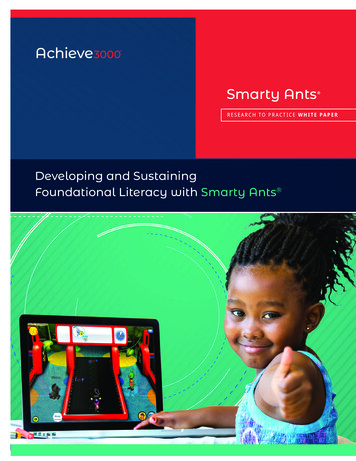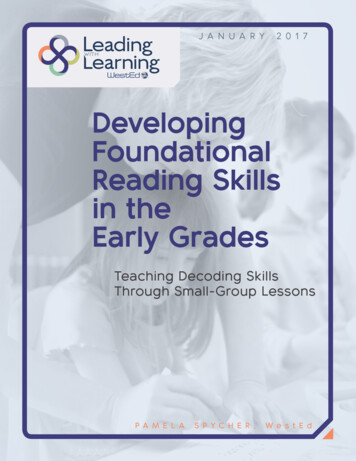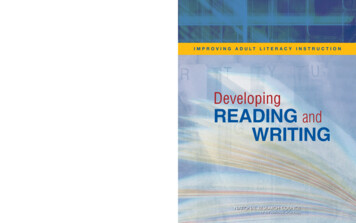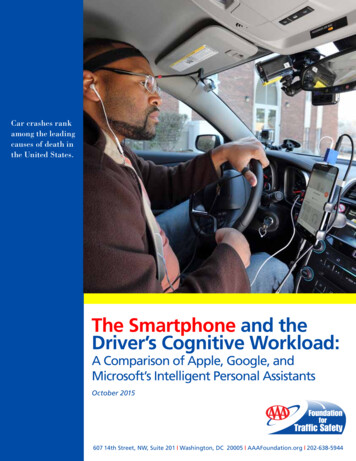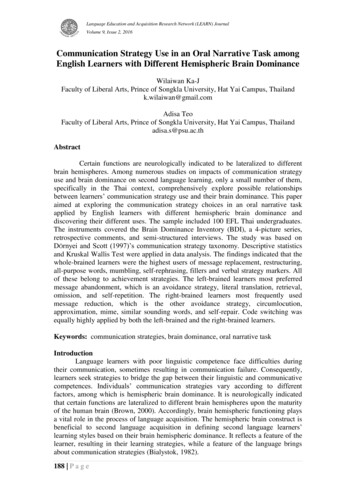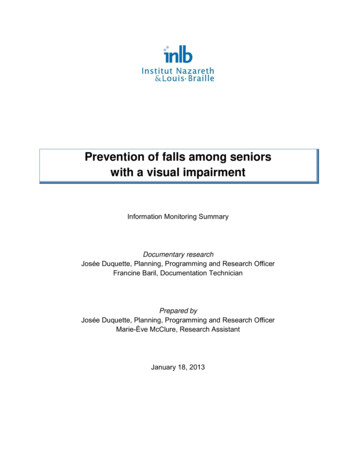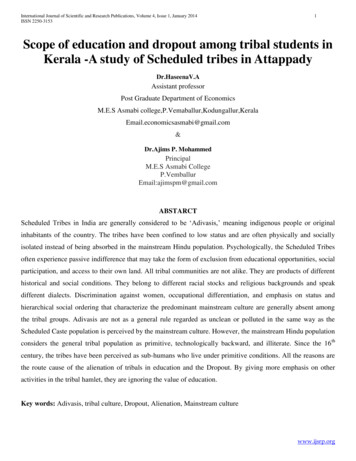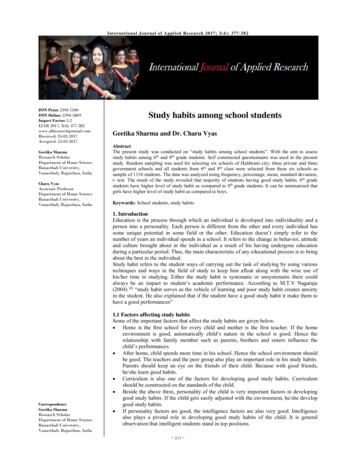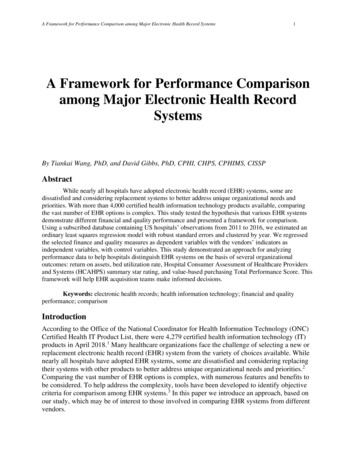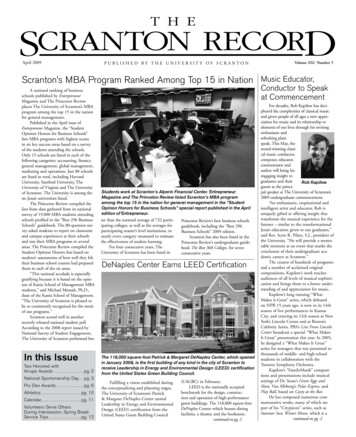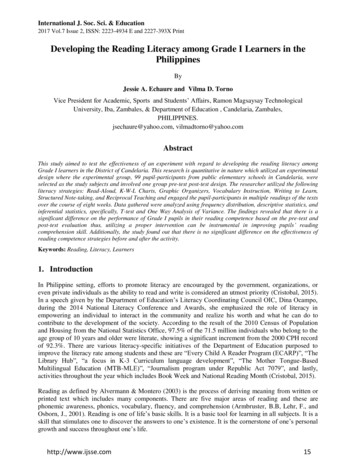
Transcription
International J. Soc. Sci. & Education2017 Vol.7 Issue 2, ISSN: 2223-4934 E and 2227-393X PrintDeveloping the Reading Literacy among Grade I Learners in thePhilippinesByJessie A. Echaure and Vilma D. TornoVice President for Academic, Sports and Students’ Affairs, Ramon Magsaysay TechnologicalUniversity, Iba, Zambales, & Department of Education , Candelaria, Zambales,PHILIPPINES.jsechaure@yahoo.com, vilmadtorno@yahoo.comAbstractThis study aimed to test the effectiveness of an experiment with regard to developing the reading literacy amongGrade I learners in the District of Candelaria. This research is quantitative in nature which utilized an experimentaldesign where the experimental group, 99 pupil-participants from public elementary schools in Candelaria, wereselected as the study subjects and involved one group pre-test post-test design. The researcher utilized the followingliteracy strategies: Read-Aloud, K-W-L Charts, Graphic Organizers, Vocabulary Instruction, Writing to Learn,Structured Note-taking, and Reciprocal Teaching and engaged the pupil-participants in multiple readings of the textsover the course of eight weeks. Data gathered were analyzed using frequency distribution, descriptive statistics, andinferential statistics, specifically, T-test and One Way Analysis of Variance. The findings revealed that there is asignificant difference on the performance of Grade I pupils in their reading competence based on the pre-test andpost-test evaluation thus, utilizing a proper intervention can be instrumental in improving pupils’ readingcomprehension skill. Additionally, the study found out that there is no significant difference on the effectiveness ofreading competence strategies before and after the activity.Keywords: Reading, Literacy, Learners1. IntroductionIn Philippine setting, efforts to promote literacy are encouraged by the government, organizations, oreven private individuals as the ability to read and write is considered an utmost priority (Cristobal, 2015).In a speech given by the Department of Education’s Literacy Coordinating Council OIC, Dina Ocampo,during the 2014 National Literacy Conference and Awards, she emphasized the role of literacy inempowering an individual to interact in the community and realize his worth and what he can do tocontribute to the development of the society. According to the result of the 2010 Census of Populationand Housing from the National Statistics Office, 97.5% of the 71.5 million individuals who belong to theage group of 10 years and older were literate, showing a significant increment from the 2000 CPH recordof 92.3%. There are various literacy-specific initiatives of the Department of Education purposed toimprove the literacy rate among students and these are “Every Child A Reader Program (ECARP)”, “TheLibrary Hub”, “a focus in K-3 Curriculum language development”, “The Mother Tongue-BasedMultilingual Education (MTB-MLE)”, “Journalism program under Republic Act 7079”, and lastly,activities throughout the year which includes Book Week and National Reading Month (Cristobal, 2015).Reading as defined by Alvermann & Montero (2003) is the process of deriving meaning from written orprinted text which includes many components. There are five major areas of reading and these arephonemic awareness, phonics, vocabulary, fluency, and comprehension (Armbruster, B.B, Lehr, F., andOsborn, J., 2001). Reading is one of life’s basic skills. It is a basic tool for learning in all subjects. It is askill that stimulates one to discover the answers to one’s existence. It is the cornerstone of one’s personalgrowth and success throughout one’s life.http://www.ijsse.com15
Jessie A. Echaure and Vilma D. TornoThe ability to read is very crucial in this generation because industrialization is taking place which is anextremely powerful force in human affairs. With the bulk of information readily available for everyone, itwould be unfortunate if an individual cannot partake of human beings’ accumulated experiences andachievement if they cannot read. Similarly, the way a man craves for basic necessities in life, manhungers and succumbs to the promise of new worlds, ideas, philosophy and a vast horizon that could beopened through reading. Reading is the ordinary individual’s passport to knowledge, his gate pass toworlds beyond imagination.Reading is the true backbone of most learning be it math, science, or even home economics hence, it isimmeasurably important. It is expected that as students climb the educational ladder, it is associated withmore reading as the subject become more dense and challenging. A study revealed that individuals bringknowledge and skill to their jobs, future studies. Despite the emphasis on the importance of reading, thePhilippine Informal Reading Inventory (Phil IRI) Oral Reading result in 2010 shows a diminishingefficiency in reading skills especially in the primary grades. This claim was supported by an alarminglevel, the numbers posted by other online articles by A previous study confirmed that the officialperformance tests on the high school students in certain 2004-2005 school year showed that only 6.59percent could read, speak and understand English. Some 44.25 percent had no knowledge of the Englishlanguage for everyone.Teachers play a major role in the development of students’ reading habits and interests which wasrepeatedly stressed by many journal articles. Educators make a difference in the success of their studentswhen they demonstrate earnest passion and believe that all children have the capacity to learn to read andmake anything happen with skills and determination. They base their classroom practices on soundreading theory, utilize different means of instruction available which are purposed to meet the specificlearning needs of students, create an organized and stimulating learning environment, and regularly assesstheir students' reading achievement. Teachers have a pivotal role in helping children to develop andmaintain a positive attitude towards learning and literacy. Motivated readers read more, use morecomplex cognitive strategies, and thus become better readers.One of the important things teachers need to do is adapt their instruction to match their students’ currentdevelopment in reading, knowing full well that children will need to spend less time developing as theyprogress, and practicing some skills and more time on others. They are expected to use classroom timemore effectively, maximize available resources to spearhead instructions among large-groups, smallgroups, and individuals. Furthermore, teachers’ expectations of and relationships with their studentsprofoundly affect students’ learning. This has been widely supported by numerous research studies inliteracy that show students are more academically successful when they feel welcomed, esteemed, andprovided with materials that challenge them hence, their knowledge, experiences, and interests areenriched. Willis (2000) noted that when these attitudes, behaviors, and curriculum considerations aremissing, there is great chance that children may resist learning, especially those who with culturally andlinguistically diverse backgrounds. This stresses the importance of expectations and relationshipsbetween teachers and students in a classroom.Teachers committed to excellence in reading instruction know that there is no single program or methodthat is effective for all as there are various considerations an educator must look into. It is of utmostimportance that teachers improve their professional knowledge individually and within a team, and viewthemselves as lifelong, reflective learners thus, they seek out opportunities to expand their knowledge byparticipating in peer coaching, mentorships, professional reading circles, networking opportunities withcolleagues, and literacy workshops and conferences. Additionally, teachers need an ongoing professionaldevelopment that allows for growth in expertise across all learning areas.16http://www.ijsse.com
Developing the Reading Literacy among Grade I Learners in the PhilippinesHerbert, Hoover High School in San Diego, California adopted seven (7) specific literacy activities whichwere found to be effective in developing the love for reading among students. Fisher (2001) enumeratedthe seven literacy activities and these are read-aloud (or shared reading), K-W-L charts, graphicorganizers, vocabulary instruction, writing to learn, structured note-taking, and reciprocal teaching. In thePhilippine setting, the Department of Education implemented the K to 12 curriculums which is in linewith the United Nation’s Millennium Development Goals, which is to promote and advance literacy;implement programs that will help learners develop their reading skills. Among the programsimplemented by Department of Education are summers reading camps and project D.E.A.R to strengthenthe reading skills of the students and remediate slow readers. Additionally, it launched “Early Language,Literacy, and Numeracy Program” last April 10, 2015 to continue strengthen their reading program.The study focused on the effectiveness of the experiment in developing the reading literacy among Grade1 students using the seven reading literacy activities. All data are sourced and collected from Grade 1students of Uacon Integrated School, Sinabacan Elementary School, and Candelaria Elementary School.2.MethodologyThe research study is quantitative in nature which utilized an experimental design. The experimentalgroup was selected as the study subjects and involved a one group pre-test post-test design. For this study,reading literacy performance was the dependent variable of the study while the seven (7) reading literacyactivities such as Read-Aloud, K-W-L Charts, Graphic Organizers, Vocabulary Instruction, Writing toLearn, Structure Note-taking, and Reciprocal Teaching are the independent variables.The participants of the study were the ninety-nine (99) students from three (3) Grade I classes of UaconIntegrated School, Sinabacan Elementary School, and Candelaria Central Elementary School. Theparticipants belonged from the cream section in Grade I and the experiment was conducted by theirteachers.Research Locale:The study was conducted in three schools at Candelaria District, Schools Division of Zambales. Figure 2shows the map of the province of Zambales showing the town of Candelaria.Figure 2 Map showing the location of the schools in the District of Candelariahttp://www.ijsse.com17
Jessie A. Echaure and Vilma D. TornoResearch InstrumentThe research instrument was developed and validated by School Principal, District Supervisor, andEducation Program Supervisor who are considered experts in literacy strategies. The Pre-Test/Post-Testreflect the following strategies: Read-Aloud, K-W-L Charts, Graphic Organizers, Vocabulary Instruction,Writing to Learn, Structured Note-taking, and Reciprocal Teaching which undergone item analysis, faceand content validation by the abovementioned experts.Data AnalysisThis study utilized descriptive statistics in analyzing collected data. Test for central tendencies werecomputed and these include the means and standard deviations. Results were sorted out and tallied.Appropriate tables were used in presenting data for variables. For a more empirical standpoint, theresearcher utilized T-test to assess whether the means of pre-test and post-test were statistically differentfrom each other.3. Results and DiscussionPre-Test and Post-Test Evaluation using Seven Literacy StrategiesTable 1 presents the summary results of the pre-test and post-test evaluation using the seven literacystrategies. For Pre-Test results, the pupils were rated “poor” in graphic organizer, writing to learn andreciprocal teaching with mean of 7.05, 7.76 and 7.91 respectively. On the other hand, their performancewas “fair” on Read -Aloud, KWL, and vocabulary study with weighted mean of 11.34, 10.23, and 25.10respectively but rated “good” in structured note taking with 6.13 weighted mean.With regard to Post-Test evaluation, the pupils’ performance was rated “good” in Read-Aloud, graphicorganizer and reciprocal teaching manifested in their weighted mean of 18.52, 19.53, and 19.93 whilepupils were rated “very good” in KWL, vocabulary study, writing to learn, and structured note takingwith weighted mean of 21.69, 45.11, 21.14 and 8.22 respectively.Data presented manifested the incremental progress of the pupils in developmental reading and writingwhich could be attributed to teachers’ dedication aided with the effectiveness of the intervention.Table 1: Summary for pre and post-test evaluationReading Competence StrategiesPre-TestScorePost-TestXQIScoreXQIRead 14821.69Very GoodGraphic Organizer6987.05Poor192319.53GoodVocabulary Study2485.525.10Fair4465.545.11Very GoodWriting to Learn7687.76Poor209321.14Very GoodStructure Note Taking607.56.13Good813.58.22Very GoodReciprocal Teaching7837.91Poor197319.93GoodDifferences on the pre-test and post test resultsThe researcher utilized T-test to determine if there are any significant differences between the means ofvariables or groups. Table 2 shows the t-test value on the result of pre and post-evaluation on the readingcompetence of Grade I pupils.18http://www.ijsse.com
Developing the Reading Literacy among Grade I Learners in the PhilippinesTable 2: t-test value on Pre-Test and Post-test evaluation on reading competencet -Test: Two-Sample Assuming EqualVariancesMeanVarianceObservationsPooled VarianceVariable 1Pre-test47.768Variable zed Mean Difference0Df196t Stat14.789t Critical one-tail1.653t Critical two-tail1.972The t-computed value is equivalent to -14.789 which is greater than ( ) 1.653 at 0.05 Alpha Level ofSignificance hence there is significant difference on the performance of Grade I pupils in their readingcompetence based on the pre and post-test evaluation.The significant difference is attributed to the effectiveness of the intervention used in enhancing readingcompetence of the pupils. Additionally, the daily exercises supplemented by varied activities resulted togreat impact on reading competence of Grade I pupils. Cekiso (2012) pointed out that a well-developedreading strategy instruction program have a strong positive effect on the English as second languagelearners’ reading comprehension and reading strategies development which is supported by the findingsof this study. In other words, a reader’s reading comprehension skill can greatly improve if a properintervention is conducted. Pupils in the experimental group exhibited greater improvement in terms oftheir performance after the intervention in comparison with pupils in the control group who showed noimprovement on the comprehension test. This indicate that reading strategy instruction can and doesmake a contribution in improving students’ performance in the reading comprehension and readingstrategy.Test of Difference on the effectiveness of the strategies for reading competenceBefore the activityThe computed F value equivalent to 0.753 is less than ( ) 2.372 at 0.05 Alpha Level of Significance.Analysis of Variance revealed that there is no significant difference on the effectiveness of the seven (7)strategies for Grade I pupils reading competence before the activity hence, the Null Hypothesis isaccepted.Table 3: Analysis of Variance to test differences on the effectiveness of strategies for readingcompetence before the activitySource ofSSdfMSFF 2.372Accept HoGroupsWithin Groups7762063522177.31Not SignificantTotal876389.3http://www.ijsse.com4119
Jessie A. Echaure and Vilma D. TornoAfter the ActivityThe computed F value equivalent to 0.015 is less than ( ) 2.372 at 0.05 Alpha Level of Significance,therefore the Null Hypothesis is Accepted, hence there is no significant difference on the effectivenessof the seven (7) strategies for Grade I pupils’ reading competence.Table 4: Analysis of Variance to test differences on the effectiveness of strategies for readingcompetence after the activitySource of VariationSSdfMSBetween Groups17678.5762946.429Within Groups687051935196300.6688819841TotalF0.015F crit2.372DecisionAccept HoNot SignificantThe results of the study revealed that the use of intervention has been proved to be effective in line withthe results of the post-test which showed incremental progress among pupils. The use of Read-Aloud,KWL, Graphic Organizers, Vocabulary Instruction, Writing to Learn, Structured Note-taking, ReciprocalTeaching has immensely improved the learning process. Pupils developed a greater sense of reading andwriting competence thereby, have meaningful learning.Ocampo (2007) has a similar observation and noted that the requisites of the reading development andperformance differ from those who are still learning to read and those who are already able to readmoreover, the following are in common: language competence, prior knowledge, connections betweenthe reader and the text, motivation to read and adequate levels of practice in reading. For developingreaders, phonological awareness is at the level significant to the orthography to be read; for English, thelevel of the phoneme; for Filipino, the level of the syllable, letter knowledge, rapid access of words fromthe lexicon or dictionary, literacy experiences; for expert readers, knowledge about the words, languagecomprehension, automatic word recognition, use of strategies to make meaning more efficient, andmeaningful reading experience.4.ConclusionsBased on the findings of the study, researcher concludes that:i.The Grade I pupils were assessed to be poor in graphic organizer, writing to learn, and reciprocalteaching; “fair” in Read-Aloud, KWL and vocabulary and “good” in structured note taking. Onthe post-test evaluation, “very good” in KWL, vocabulary study, writing to learn and structurednote taking and “good” in read-a-loud, graphic organizer and reciprocal teaching.ii.The reading competence of the pupils has improved after the intervention strategy.iii.There is significant difference on the performance of Grade I pupils in their reading competencebased on the pre and post-test evaluation.iv.There is no significant difference on the effectiveness of the reading competence strategies.20http://www.ijsse.com
Developing the Reading Literacy among Grade I Learners in the PhilippinesReferencesAlvermann, D. E. & Montero, M. K. (2003). Literacy and Reading. In Encyclopedia of Education (Vol.4, pp. 1513-1518). New York: Macmillan.Armbruster, B. B., Lehr, F., & Osborn, J. (2001). Put Reading First: The research building blocks forteaching children to read: Kindergarten through grade 3. Washington, DC: CIERA.Cristobal, L. (2015). Literacy in the Philippines: The Stories behind the Numbers.Fisher, C., Researching and Writing a Dissertation: A Guidebook for Business Students. Financial TimesPrentice Hall,2007.Willis, (2000). Quarterly Review of Distance Education: Volume 4 Book. edited by Michael Simonson,Charles Schlosser.http://www.ijsse.com21
implement programs that will help learners develop their reading skills. Among the programs implemented by Department of Education are summers reading camps and project D.E.A.R to strengthen the reading skills of the students and remediate
